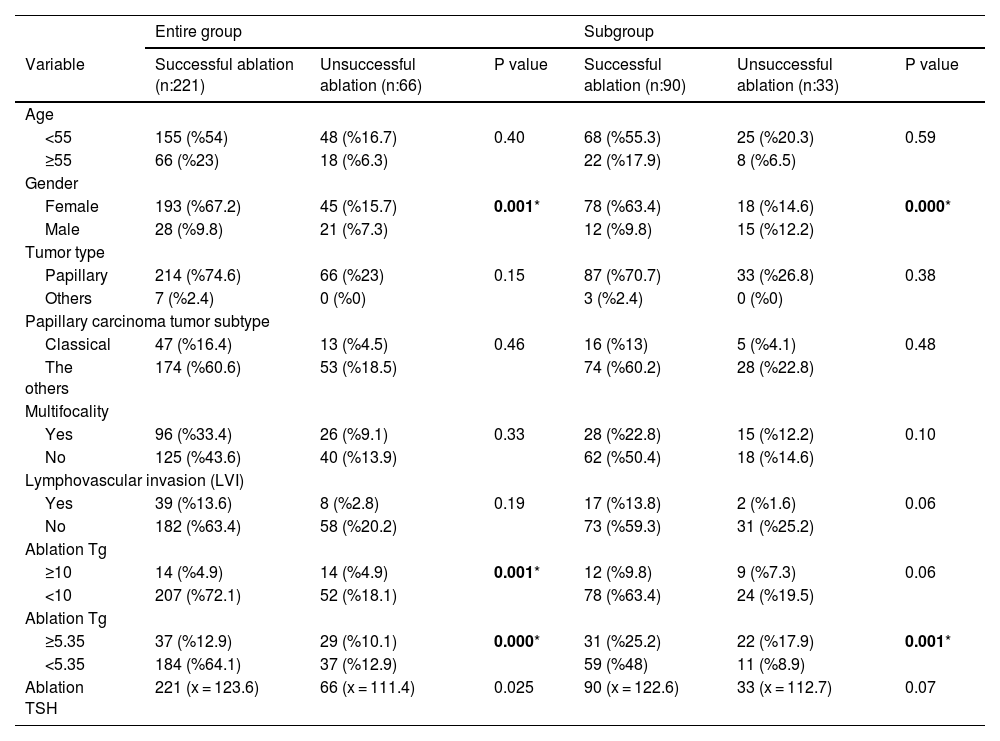Ablation therapy is employed in low-risk differentiated thyroid cancer (DTC) cases to facilitate patient monitoring by reducing thyroglobulin (Tg) levels to measurable levels below after surgery by eliminating residual thyroid tissue. However, there is still uncertainty about the minimum activity dose required for effective ablation. Opting for low-dose [131I]-NaI for ablation offers several advantages for both patients and healthcare services. Particularly in this tumor group with a high life expectancy (approximately 90–95 % at 10 years), [131I]-NaI treatment should not pose a risk to the patient's post-treatment life and should not compromise their quality of life. However, there is a need for a well-defined identification of factors predicting successful ablation.
MethodsClinical data, laboratory findings, and imaging tests of 287 patients with low-dose 1110 MBq (30 mCi) [131I]-NaI ablation therapy for DTC were retrospectively reviewed. Post-ablation imaging and laboratory findings categorized ablation success/failure. The successful ablation group was determined according to the excellent response criteria outlined in ATA criteria. Relationships between clinical, pathological findings, biochemical common variables, and treatment failure were analyzed.
ResultsAn excellent response was achieved in 77% of the entire group according to ATA criteria post-ablation. Male gender and high Tg levels on the day of ablation (Tg cut-off: 10 ng/mL and 5.35 ng/mL) were associated with unsuccessful ablation.
ConclusionsOur results indicate that a 1110MBq (30mCi) ablation dose is sufficient to achieve an excellent response in most low-risk DTC cases 6–12 months later. When selecting the dose for ablation, besides the histological markers mentioned in guidelines and age, we observed that stimulated Tg values and gender may be important in predicting ablation success.
La terapia de ablación se emplea en casos de cáncer diferenciado de tiroides (CDT) de bajo riesgo para facilitar el seguimiento del paciente al reducir los niveles de tiroglobulina (Tg) a niveles mensurables por debajo después de la cirugía mediante la eliminación del tejido tiroideo residual. Sin embargo, todavía existe incertidumbre sobre la dosis mínima de actividad necesaria para una ablación eficaz. Optar por dosis bajas de [131I]-NaI para la ablación ofrece varias ventajas tanto para los pacientes como para los servicios sanitarios. Particularmente en este grupo de tumores con una alta esperanza de vida (aproximadamente 90–95% a los 10 años), el tratamiento con [131I]-NaI no debería suponer un riesgo para la vida post-tratamiento del paciente y no debería comprometer su calidad de vida. Sin embargo, existe la necesidad de una identificación bien definida de los factores que predicen una ablación exitosa.
MétodosSe revisaron retrospectivamente los datos clínicos, los hallazgos de laboratorio y las pruebas de imagen de 287 pacientes con terapia de ablación con dosis bajas de 1110 MBq (30 mCi) de [131I]-NaI para el CDT. Las imágenes posteriores a la ablación y los hallazgos de laboratorio clasificaron el éxito/fracaso de la ablación. El grupo de ablación exitosa se determinó de acuerdo con los criterios de respuesta excelente descritos en los criterios de la ATA. Se analizaron las relaciones entre los hallazgos clínicos, patológicos, las variables bioquímicas comunes y el fracaso del tratamiento.
ResultadosSe logró una excelente respuesta en el 77% de todo el grupo según criterios ATA post-ablación. El sexo masculino y los niveles altos de Tg el día de la ablación (límite de Tg: 10 ng/mL y 5,35 ng/mL) se asociaron con una ablación fallida.
ConclusionesNuestros resultados indican que una dosis de ablación de 1110MBq (30mCi) es suficiente para lograr una respuesta excelente en la mayoría de los casos de CDT de bajo riesgo entre 6 y 12 meses después. Al seleccionar la dosis para la ablación, además de los marcadores histológicos mencionados en las guías y la edad, observamos que los valores de Tg estimulados y el sexo pueden ser importantes para predecir el éxito de la ablación.
Article

Revista Española de Medicina Nuclear e Imagen Molecular (English Edition)









